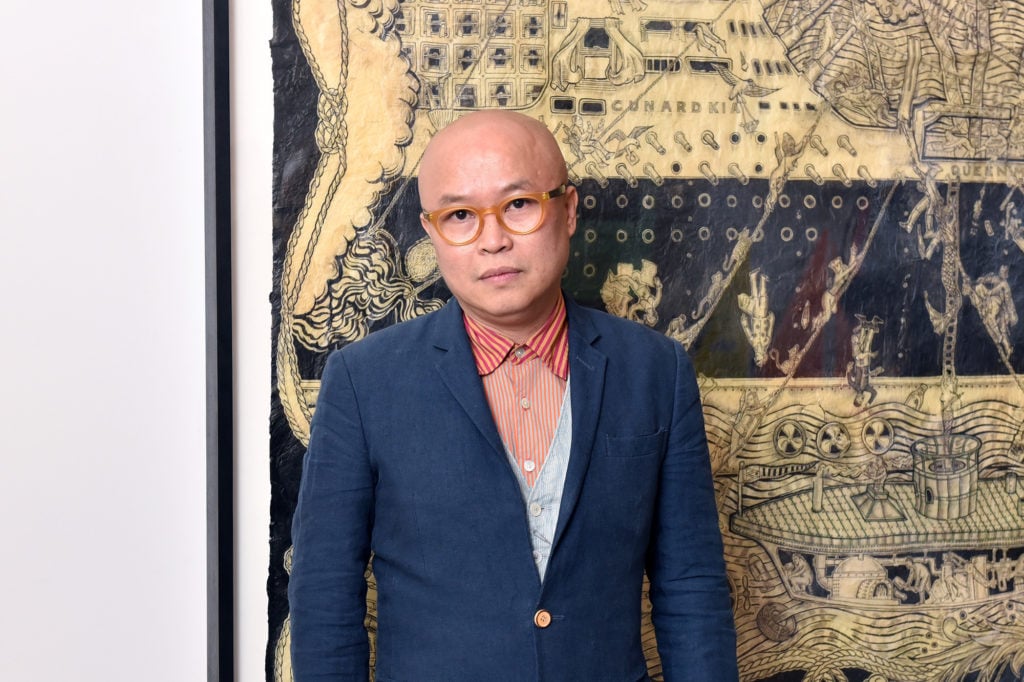Art World
‘The Brooklyn Rail’ Will Relaunch With a Bigger Staff and More Reviews, Says Phong Bui
A clash of visions is behind the shakeup at the venerable Brooklyn publication.

A clash of visions is behind the shakeup at the venerable Brooklyn publication.

Ben Davis

On Friday afternoon, news broke of big changes at the well-regarded publication the Brooklyn Rail. Details were scarce, but a statement that went out from the Rail said that its board of directors, as well as “day-to-day senior staff and six additional full- and part-time staff members,” were all parting ways, effective next week.
With no further information available from anyone involved with the publication, speculation about the future of the Rail filled the void, much of it centering on the idea that the publication was closing.
However, this weekend, Phong Bui—long the central figure associated with the venerable Brooklyn publication—sought to quell the rumors. In a statement, he described the break as amicable, growing from a “process of re-envisioning” the journal’s future.
“We have already and seamlessly hired a new and enlarged staff team, as well as secured additional board support,” the statement assured. “The Rail will therefore fully continue its ongoing mission to enliven the arts and writing community. We look forward to sharing the next issue in due course, which will be released on our normal publication schedule.”
Reached by phone on Sunday, Bui framed the transition as stemming from a clash of vision between himself and the outgoing staff. (None of the staff members I reached out to wanted to comment on the record for this story.)
“They are doing it for the good of the Rail, in a way,” he said of the departures. “It’s like a marriage that that has gone wrong. It is better that the father and the mother part ways.”
In recent years, the Rail has been professionalizing its operations. As of May 2016, it started paying its writers after a long history of doing otherwise. In September 2016, it brought on Amy Ontiveros as consulting editorial director, to consolidate the ArtSeen and Art in Conversation sections under one editor.
These changes, however, were accompanied by unwelcome side effects for Bui. “I was marginalized from my usual publisher/editorial role,” he explained.
(Bui was editor-in-chief of the Rail for two years, between 2013 and 2015. Before that time, the role had been held by founding editor-in-chief Ted Hamm, with Bui as publisher. According to those with familiarity of the Rail‘s operations, there is currently no editor-in-chief, with the publication’s Books, Poetry, Film, Music, Dance, Field Note, Theater, Fiction, and Art Books section edited autonomously.)
Bui found himself losing influence over the Rail’s art section—a centerpiece of the publication, as he sees it, given that his fundraising efforts are focused on raising support from artist foundations.
The tone of the art content also underwent an unwelcome change, in Bui’s estimation. “A lot of our great old writers have been turned down by Amy [Ontiveros],” he said. “These were the traditional writers who made the Rail great.”
With the new editorial priorities, Bui felt the publication was losing its unique identity in an attempt to cater to contemporary art industry passions, becoming “not only dumbed down, but also predictable.” He said he values a “bohemian” spirit that was being lost.
“Why should the Rail compete with Frieze, with Artforum?” he said. “These are long-established art publications. The Rail should figure out its own contribution.”
His own vision, he said, was an “October magazine for the people,” referring to the venerable art-theory journal—high minded but with a popular touch.
Bui would not say if any specific incident had precipitated Friday’s wave of departures. “I think people agree that stepping down is the way to let me rebuild the Rail the way I see it,” he said. “Hopefully, the new crew coming in will help build that collective vision.”
Details about the new staff and board members would not be made public until the current transition was complete, he said, though he said that readers could expect a “new website person and amazing graphic designer.”
What will the post-transition Brooklyn Rail look like? Bui stressed that he wanted to see review coverage that was both expanded and more timely. He mentioned a target of publishing 20 reviews in the paper, plus 20 additional reviews online each month. He would be “bringing back the old gang [of writers] and adding more,” he promised.
Would all this come at the expense of its recent advances in compensation? On the contrary, Bui said. By the end of the year, he hopes to be paying $150 per review, up from the current $50 to $75.
For the last year and presently, Bui’s title on the masthead has been “Co-Founder and Artistic Director.” With the shakeup, he says he plans to reclaim the title of “Publisher.”
“It’s going to be a better future, I assure you,” he concluded.